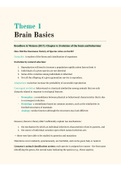Summary
3.6C The Brain Theme 1: Brain Basics (Summary)
- Course
- Institution
Complete summary of the literature for 3.6C "The Brain" Theme 1: Brain Basics for the Psychology "Brain and Cognition" specialisation. The summary covers the following book chapters: Breedlove & Watson (2017). Behavioural neuroscience Chapter 6: Evolution of the brain and behaviour (pg 163 - 191) ...
[Show more]



